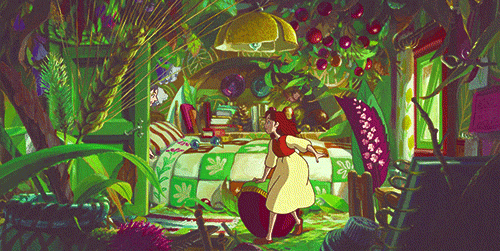Hayao Miyazaki is a Japanese filmmaker with a genius for
interpreting the magic of English children’s literature. As with Howl’s Moving Castle, The Secret World of Arrietty is an
adaptation of a book that I adore.
When I say I adore Mary Norton’s The Borrowers series, I mean I was obsessed with it, even more so than with books like The Indian in the Cupboard by Lynn Reid Banks. (This
obsession struck me right after my horse phase, and seems as essential a part
of my girlhood as anything.) Riding in
the car, I would look out for exposed tree roots and hiding places that would
make good Borrower nests. In my bedroom closet, I used pins and string to make
it easier for the Borrowers to climb to the top of my shelves. In the backyard,
I used leaves and stones to furnish a tiny 'house', imagining what it would be
like to see the world from such a tiny perspective.
 |
| A teeny tiny jungle of a room - just as it should be |
So when I heard that my favorite filmmaker, Hayao Miyazaki,
was adapting The Borrowers, I was
thrilled. I couldn’t imagine a more perfect imagination to transform this book.
There are beats in The
Secret World of Arrietty that seem strange to me: Sho casually telling
Arrietty that it’s likely her kind is doomed to extinction (I realize that he is facing his own mortality, but it's still a dick move), the housekeeper’s strangely reckless attitude toward the little people she's heard so much about, and the uncertainty of the ending. Will Sho survive? Will the tiny family? The American version tidies these
ambiguities up neatly with narration, but the Japanese version does not.
As with the placid lakeside scenes of Howl’s Moving Castle, Miyazaki is interested in making us feel this
world and how the characters live inside of it. The sound of a cat walking
through grass is crashingly loud. Crows and rats are menacing, and a human
boy’s casual attempts to “help” are disastrously disruptive and terrifying to
his tiny neighbors.
Through Miyazaki’s storytelling, I understand why Homily
loves her safe, comfortable home furnished with scavenged and repurposed items,
and why Arrietty is eager to explore the unimaginably vast world outside.
Miyazaki’s films succeed in the realm of fantasy because he is always
interested in setting, and worldbuilding is crucial in that genre.
As with any Miyazaki movie distributed by Disney, it can be
helpful to watch it twice—once in subtitles with the original Japanese voices,
and once with the American dubbing. (Or watch the American dubbing with the
subtitles turned.) The versions are noticeably different. For example, Homily
Clock, Arrietty’s mother, is considerably altered between versions; her
fussiness and nervousness are emphasized for comedic effect in the dubbed, but
her concerns seem more rational and less self-centered in the Japanese.
A movie cannot fully match my imagination, but The Secret World of Arrietty transformed
my memories and enriched them with Miyazaki’s vision. I love this movie, no
matter what its miniature flaws may be.
I am thrilled beyond belief to hear that Miyazaki is planning on coming out of his semi-retirement to expand a short film Kemushi no Boro (Boro the Caterpillar) into a feature-length film. More Miyazaki,
please!
No comments:
Post a Comment